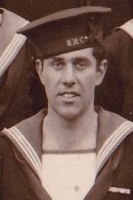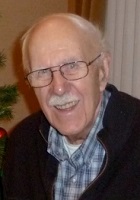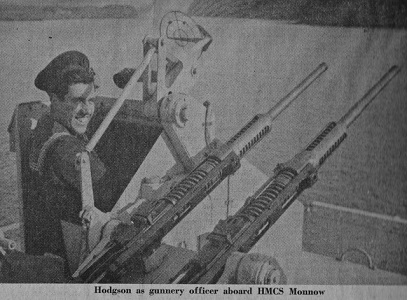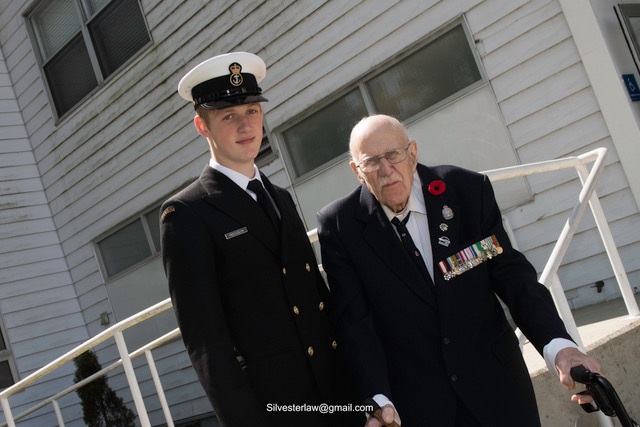|
In memory of those who have Crossed the Bar
HODGSON, Stuart M. - It is with heavy hearts that we announce the passing of Stuart Milton Hodgson at age 91 on Friday, December 18, 2015.
Stuart was born on April 1st, 1924 in Vancouver BC, the second son of Allan and Mary Hodgson. He attended public school at Walter Moberly and John Oliver, completing Grade 11 (and voted least likely to succeed by his peers) while working in the plywood mills from age 15 to support his family during the depression.
Stuart joined the RCN Reserves at HMCS Discovery in WWII and served as a gunner on the frigate HMCS Monnow with Escort Group 9 on the treacherous Murmansk run where he shot down a German Luftwaffe Ju88 off the Norway coast, provided Shore Patrol duty while in port in Londonderry (and broke up more than a few fights) and was present for the surrender of the German U-Boat fleet of Trondheim at wars end.
After the war he returned to BC to work in the plywood mills of MacMillan Bloedel and soon became involved in the rough and tumble world of labour politics where he rose to the position of Financial Secretary at Local 1-217, the IWA’s largest local in one of the Canada’s largest and most militant unions.
During his trade union career he served in many positions with the Vancouver Labour Council. His open door, open mind mantra became the cornerstone of this and subsequent career successes. He was a member of the IWA Executive Board, Vice President of Western Regional Council #1 and an Executive Member of the Canadian Congress of Labour where in 1955, he attended the World Congress of the ICFTU in Vienna Austria. He also served on the BC Federation of Labour Executive Council.
His time with the IWA shaped both his career and outlook, nurturing what became a life-long commitment to equality and acknowledging the contributions of First Nations and women in Canadian history and society. He believed both were unsung heroes. Stuart was one of the ten founding signatories of the NDP along with his mentor Tommy Douglas in 1961.
In 1964, he was appointed a member of the Council of the Northwest Territories. The following year he accepted the appointment as the first full-time Deputy Commissioner of the Northwest Territories and moved to Ottawa, which by federal law was the Capital of the NWT.
Stuart is best remembered for his achievements as Commissioner of the Northwest Territories. He was appointed by Prime Minister Pearson on the recommendation of his mentor, Arthur Laing, the Minister of Indian and Northern Affairs in 1967. Concerned that he knew “nothing about running a government” Mike Pearson quipped,” that is actually why I am appointing you”.
Within months of his appointment as Commissioner, he developed a fledgling civil service. In September 1967 he moved his 30 employees from Ottawa, some 1,800 miles distant, to the new capital of Yellowknife, a small, isolated mining town on the north shore of Great Slave Lake. Houses had yet to be built and offices were in a dilapidated, condemned school.
The vast Arctic which lay beyond had become his responsibility. The population of 22,000 people were scattered in 72 isolated communities and camps over 1,300,00 square miles, an area almost half the size of the United States.
His role in the North speaks of an unforgettable time and place. He had a profound respect for its people and often spoke of his time there as the best of his life. Affectionately known by the Inuit as Umingmak (Musk-Ox) for his strength, endurance and protective presence, he travelled extensively throughout his twelve years as Commissioner, visiting every community annually and encouraging open, inclusive dialogue in his community meetings. His leadership forged a clear and uniting Northern identity, laying the building blocks for a sustainable political structure and economy.
The North was fraught with problems: the staggering distances, inadequate communications and the fact that the Central and Eastern Arctic areas were so far removed from Yellowknife, it should have been another country. He realized there was no instant solution and that the key to bringing the northern population into the mainstream of Canadian life was to develop local government by decentralizing power into the regions and local communities.
To unite the North and its people he devised a grand scheme to celebrate a 100-year birthday, a Centennial, a year-long celebration of Northern culture, celebrations and events, which brought official visits by Prime Minister Pierre Trudeau, Governor General Roland Michener and Queen Elizabeth with the Royal Family along and many foreign dignitaries. He also co-founded and hosted the first ever Arctic Winter Games in Yellowknife. Stuart appointed an Inuk, Abraham Okpik, to head up Project Surname, replacing the Eskimo Disc System, introduced by the federal government in the 1940’s, and gave the Inuit people back their names.
He was passionate about Arctic history and created the Franklin Probe, which sought to record all the Franklin artifacts and history available at the time. He travelled in search of the lost Franklin expedition for several summers. Stu was farsighted in his vision for a sustainable NWT. One of his legacies was to develop tourism as a cornerstone of the NWT’s economy, which has blossomed in subsequent years. Stu was instrumental in the creation of the 3 legged polar bear, a lasting symbol of Canada’s arctic and a Travel Arctic icon that is known throughout the world and still serves as the licence plate in both the NWT and Nunavut.
He presided over the affairs of the Council of the Northwest Territories, the legislative arm consisting of both appointed and elected members. He controlled the process as both Speaker and Leader. His administration wrote the laws, developed the financial budgets and asked the Council to pass the ordinances and bills before them. Finally, in 1975, sensitive to the changing aspirations and political landscape of the NWT and its people, he relinquished his authority over the Council and handed over control to the fully elected Council, the predecessor of the Legislative Assembly of the Northwest Territories.
As a final undertaking before leaving the North he invited Prince Charles to open, the Prince of Wales Northern Heritage Centre. This was one of his proudest moments as Commissioner of the NWT.
After leaving the North, Stu was appointed Chairman of the International Joint Commission where he settled 21 longstanding disputes between Canada and the US. Drawing further on his union background and leadership roles he then took the helm of the BC Ferry Corporation, where he used his union background to bring labour stability by spending time with the crews on board the ferries and the employees in the terminals, to better understand their issues, while overseeing the construction of a new fleet of ships. Stuart then moved on to Chair BC Transit and ensure that the construction of the Skytrain system was built in time for Expo 86. He also played a pivotal role in the decision to make the Vancouver airport an independent authority to better serve the needs of BC.
Stuart’s final opportunity to serve his beloved Canada came 1997 when he was appointed a Citizenship Judge by Prime Minister Chretien and where he served until his retirement in 2005. He enjoyed the opportunity to meet and swear in so many new Canadians and to provide his own unique advice to new citizen’s. “I always say, wives, walk beside – not behind- your husbands as you enter the chamber for your ceremony. Here in Canada women are equal partners to men. As new Canadians you both must honour that reality in the ceremony as in life.”
He was an Officer in the Order of Canada, a Knight of the Order of St John, a Distinguished Member of the RCMP, an Honourary Colonel of the 1st Canadian Ranger Patrol Group, a recipient of the public service’s Outstanding Achievement Award in 1976,an Honourary Canada Lands Surveyor and a Doctor of Law (U of Calgary).
Stuart was a patient, kind spirited, generous and hard working man who loved his family and friends. They in turn adored him. His glorious stories will live on in their hearts and around many dining tables.
Stu was predeceased by his beloved wife Pearl in 2003. He is survived by his son Eugene (Karen) and grandsons Stuart and Evan, daughter Lynne and grandchildren Sarah, Travis, Kyle and Brittany, all of whom he loved very much.
Special thanks to the “darling” staff at Crofton Manor and his care-givers Socorro and Cecilia.
A memorial service is scheduled for January 14th, 2016 at 2:00pm in Vancouver B.C. at HMCS Discovery in Stanley Park.
Ships served in:
|
|||||||





